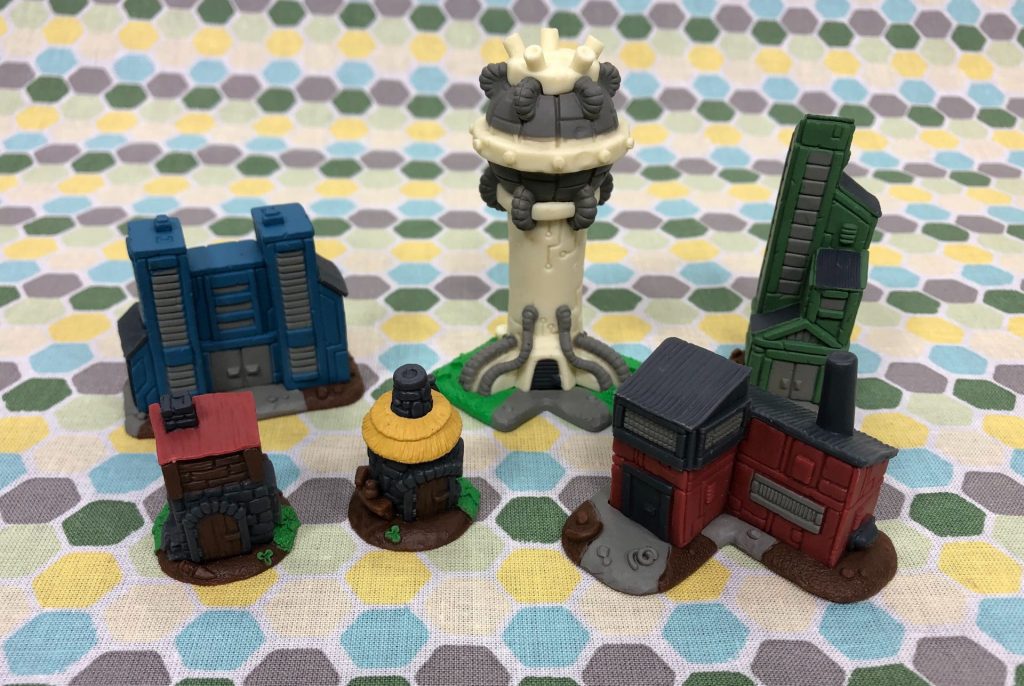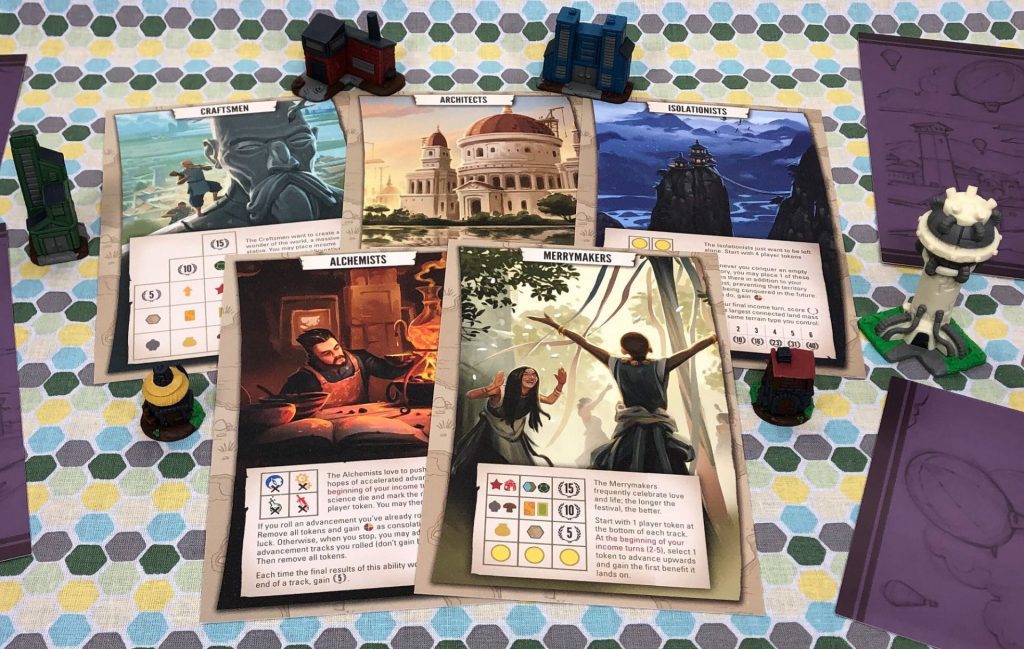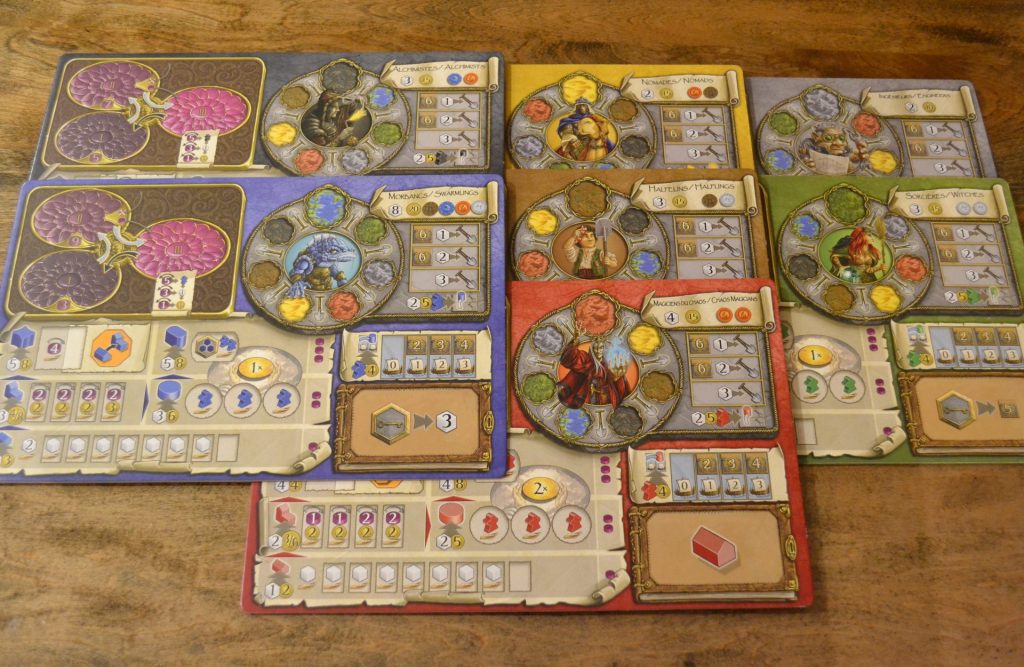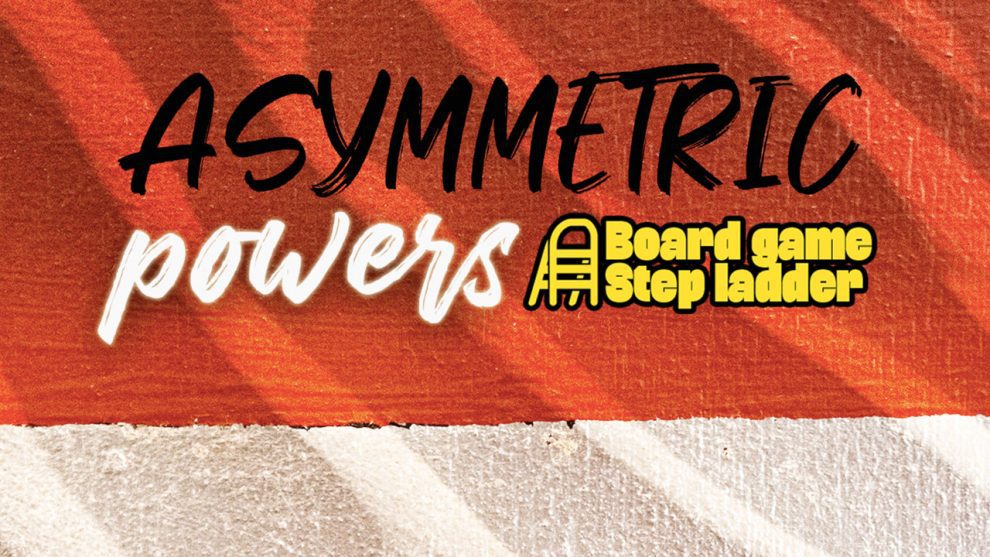Today’s Step Ladder is about asymmetric powers.
In a symmetric game, every player plays the game exactly the same. While some differences may emerge during game play, the players begin the game with the same actions or abilities and will largely follow the same rules throughout the course of the game. Consider a game like Dominion, for example. In this deck building game, each player begins with the exact same deck of cards looking out over the exact same layout of cards as every other player. It is only through the randomness of their card draws and the decisions that they make during the game that the game’s symmetry begins to melt away.
In an asymmetric game, each player begins the game differently than everyone else. While the winning conditions are the same for everyone (be the first one to score 30 points, end the game with the most money, etc.), each player will be pursuing very different paths to achieve that goal. And when it comes to asymmetry, there are two distinct types: asymmetric powers and asymmetric roles.
The distinction between the two is not always easy to draw, and some games may implement both making the lines even more blurry. In a game like Root, each player is trying to achieve the same goal, but each player’s faction is so vastly different from each other’s that it’s as if each player is playing an entirely different game. Understanding how the Eyrie is played will not help you master the Woodland Alliance, for instance. The roles are just so dissimilar. This is an example of asymmetric roles. With asymmetric powers, the players play the game the same way, but each player has access to various specialties that make them better at some aspects of the game while perhaps not being as good at others. These specialties not only provide unique abilities but they’re often used as a guidepost to help the player navigate the game’s mechanics in their quest for victory.
That’s what this Board Game Step Ladder is all about: asymmetric powers. Today we’re going to talk about games where each player begins the game with some unique ability that sets them apart from each of their opponents.
Santorini -> Tapestry -> Terra Mystica
Santorini
Santorini’s been around since 2004, but didn’t really catch on until 2016 when Roxley Games got hold of it and put it up on Kickstarter with updated components and artwork. The bright vibrant colors, clean lines, and cheeky artwork has a certain mass appeal and the 3D game board setup is undeniably eye catching. After a whirlwind campaign that made over $530,000, the game quickly went into production and backers began receiving their copies in early 2017.

The objective of the game is simple: be the first person to end your turn on the third level of a building. The rules of the game are simple, too. On a player’s turn, they move one of their two pawns into an adjacent space. They can only move up a single level at a time. So if they’re on the ground level, for instance, and the space they’re wanting to move into already has a two-story building on it, they won’t be able to move there. Then they build something in a space next to wherever they wound up. If that space is empty, they construct the first level of a house. If there’s already a level, they build the next level. The final level, the roof, prevents anyone from ever occupying that third level which, as I mentioned before, is how the game is won.
Now, there’s nothing particularly innovative about moving a playing piece around a board and constructing things. Lots of games feature mechanics like that. What sets Santorini apart is the asymmetric powers that come in the form of God cards. At the beginning of the game, the players have an opportunity to choose one of these cards to use for the rest of the game. These God cards come in three flavors — some provide alternate methods of movement, some provide alternate win conditions, and some affect your opponent’s workers when certain criteria are met. And this is the crux of Santorini right here. This is what really sets the game apart from every abstract out there and makes it something really special. Aside from providing the players with unique, game changing abilities, these God cards also provide something else essential to the game — replayability. With over 30 different God cards right out of the box, there are tons of combinations to try.

Santorini is an excellent example of a game that tackles asymmetry very well. Its small footprint, its presence on almost every game shelf in every store everywhere, its quick playing time, and its easy-to-learn rules set makes Santorini a very approachable game. Ostensibly it can play up to 4 players, but it’s really a game designed for just 2. The next game on our Step Ladder serves not only as a step up in the player count but also complexity as well.
Tapestry
Tapestry is a game all about scoring as many victory points as you can in a limited amount of time. The game takes place over five eras, but the twist is that each era will come to an end for each player at different times. This is because each era is a test of efficiency and maximization. Played well, a player can make a single era last for a while, milking a lot of victory points out of it along the way. Played poorly, a player’s era may only consist of one or two actions before it comes to an end and they are forced to move on to the next one.
The game takes place in equal parts across a central game board that features a map in the center that is divided into hexes. This is surrounded by four different technology tracks. As players progress along the tracks they will score victory points, have opportunities to interact with the map (exploration, building, military conquest, etc.), learn new technologies that provide them with special benefits (free movement along the technology tracks, free interactions with the map, free resources, etc.), and other things including the ability to construct buildings in their own player area.

In Tapestry, each player has their own play area consisting of an income mat, a capital city mat, as well as a unique civilization mat. The income mat has four different income tracks that are divided into different sections. Most of these sections are covered with buildings at the beginning of the game and the players will have the ability to construct them at some point (add them to their city mats) in order to uncover the icons underneath. During the income phase at the beginning of each era players receive income based on whichever icons are uncovered, so constructing buildings is very important.
The capital city mat is just a mat made up of squares where players will be placing the buildings that they construct during the game or the ones that they might unlock by progressing along the technology tracks faster than the other players. Players are going to want to fill in as many of these squares as they can as quickly as possible because doing so will earn them victory points and free resources. Each of these game elements all work together to present a well-polished game that presents an interesting challenge every time you play it. But what lands this game on this list are the unique powers introduced by way of the civilization mats.

During setup each player will be given two of these mats randomly and will have to select one to use for the remainder of the game. These civilization mats give each player some kind of special power that will make them vastly different from every other player. One civilization might encourage a player to focus more of their attention on the map in the center of the table, providing them with special benefits that allow them to interact with that game element in some unusual way while another civilization mat might encourage a player to forgo the capital city mat by giving them an alternate place in which to construct their buildings. These are just a couple of examples, but the game comes with 16 different civilizations to choose from right out of the box.
As complicated as this might all sound, though, Tapestry is a cakewalk compared to the next game on this list and has even taken a few cues from it as well.
Terra Mystica
Even though it’s only 8 years old at this point, Terra Mystica is considered by many to be one of the board game greats. For a long time it sat atop the throne of BoardGameGeek’s ranking ladder as one of the best games. It is only within the last couple of years that it has fallen in the ranks where it now resides in the number 14 spot. Its tried and true mechanics have withstood the test of time and its influence can be seen in many more recent board games from 2017’s Gaia Project (a direct sequel to Terra Mystica) and Clans of Caledonia to the aforementioned Tapestry. We’re pretty fond of it here at Meeple Mountain and while it may not have been the first game to ever feature asymmetric powers, it was one of the first to do it well. The fact that Terra Mystica continues to be such a well-respected and revered game serves as a testament to that legacy.
Much of what I am about to describe may seem familiar…
Like most euros, Terra Mystica is a game all about scoring more victory points than your opponents before time runs out. The game is played over the course of 6 rounds. Each round has its own set of randomly selected scoring criteria broken into two parts: points for constructing certain kinds of buildings and a bonus for your position along the cult tracks.
The physical game space is divided into three main sections: the main game board, the cult track board, and the player mats. The cult track board displays 4 different tracks that the players will have the opportunity to invest effort into in order to move along the tracks to earn points and bonuses. The main game board is a map divided up into different colored hexagons with each color representing a specific terrain type. There are also a few rivers that run across the map dividing up the landmasses into different regions. This is where players will be constructing the buildings that they’ll find on their player mats.
The player mat is divided into 3 main sections. The top left of the player board depicts the “bowls of power” — three circles which are stocked with little purple “power” tokens. A large part of the game revolves around the management of these power tokens as they can be spent to purchase certain resources or perform certain actions. In order to use them, though, they must cycle from Bowl 1 to Bowl 2 and then back into Bowl 3. It sounds like an easy task, but there are quite a few of these tokens and you’ll only be moving a few at a time. There are ways to “burn” power (i.e. remove a token from the game) to make the cycling go faster, but once they’re gone, that’s it. You’ll never get them back.

Beneath the bowls are the buildings. Each building sits on top of an icon that, when uncovered, depicts what the player will receive in income once the building has been constructed. This may sound familiar from my earlier description of Tapestry. But one of the things that makes Terra Mystica so much more difficult is that the buildings sort of act as technology tracks. One type of building will eventually upgrade into another and when this upgrade is performed, the building being upgraded is returned back to the player mat which covers up a previously uncovered icon. While expansion is a necessary evil in Terra Mystica, you’ll always be giving up something useful to gain something else.
The only way to gain access to everything is to eventually build everything and that is much more easily said than done. This is primarily due to the terraforming element of the game. Each faction in the game prefers to build only on a certain terrain type. In order to build in a terrain hex that is not of the preferred type, the players must expend resources in order to transform it into the terrain that they do prefer. The right hand side of the player board shows the terrain circle. The further away the target terrain is on the circle from the preferred terrain type, the more resources it’s going to cost. And there are never enough resources for you to accomplish everything you’d really like to accomplish. Fortunately, Terra Mystica has a built-in mechanism that will assist you in your endeavors and it is this mechanism that lands Terra Mystica on this list. You guessed it: asymmetric powers.
Terra Mystica comes with 14 distinct factions which each feature a unique game-breaking ability. Some like the Halflings, who get victory points every time they gain spades (the resources used for terraforming), are very easy to wrap your head around while others, like the Giants, who require just two spades to terraform (regardless of how far along the circle the target terrain is), are a bit more difficult to master. Every faction’s ability is very different from every other one. While these faction abilities don’t have to shape your strategy, it is unwise to ignore them.

And this is just the tip of the iceberg. There are several other aspects of the game that I haven’t even touched on here. Suffice it to say, Terra Mystica is a very challenging game to learn, to play, and to master but it is a very rewarding experience. Give it a try for yourself and you’ll see why it continues to enjoy the success it has. It is truly a worthy contender for the top rung of this Step Ladder.











Add Comment